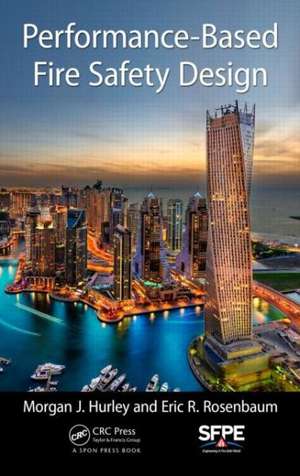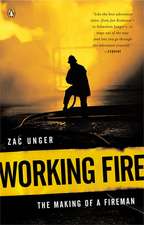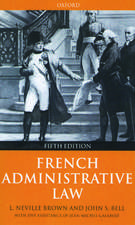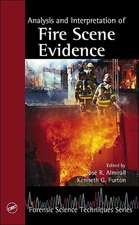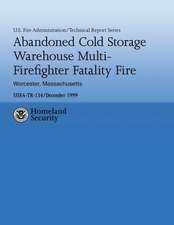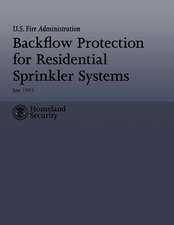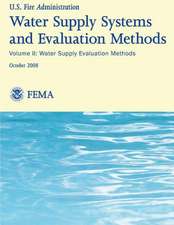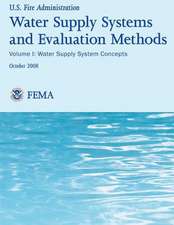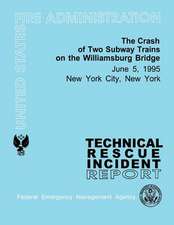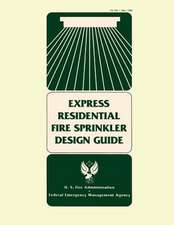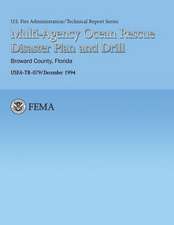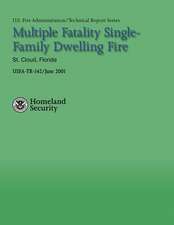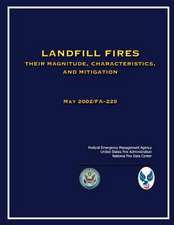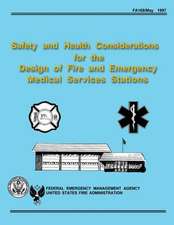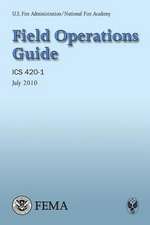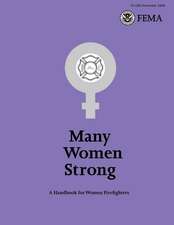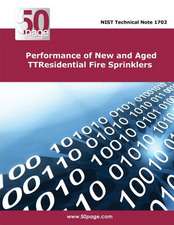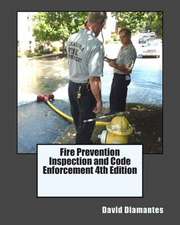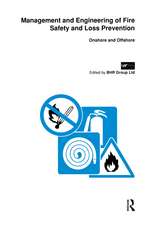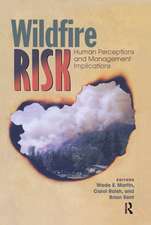Performance-Based Fire Safety Design
Autor Morgan J. Hurley, Eric R. Rosenbaumen Limba Engleză Hardback – 14 apr 2015
Performance-Based Fire Safety Design demonstrates how fire science can be used to solve fire protection problems in the built environment. It also provides an understanding of the performance-based design process, deterministic and risk-based analysis techniques, development of design fire scenarios, trial design development and analysis, and building lifecycle management.
Develop a Strategy That Meets the Fire Safety Goals for a Building
Topics addressed include designing to protect people from fire, design of detection systems, smoke control systems and structural fire resistance, addressing computational and design uncertainty, and fire testing to support design development or evaluation.
- Identifies key attributes of performance-based design
- Reviews the advantages and disadvantages of performance-based design over specification-based prescriptive design
- Provides a series of steps offering a framework/process for performance-based design
| Toate formatele și edițiile | Preț | Express |
|---|---|---|
| Paperback (1) | 410.28 lei 6-8 săpt. | |
| CRC Press – 10 dec 2019 | 410.28 lei 6-8 săpt. | |
| Hardback (1) | 569.45 lei 6-8 săpt. | |
| CRC Press – 14 apr 2015 | 569.45 lei 6-8 săpt. |
Preț: 569.45 lei
Preț vechi: 669.93 lei
-15% Nou
Puncte Express: 854
Preț estimativ în valută:
108.98€ • 113.35$ • 89.97£
108.98€ • 113.35$ • 89.97£
Carte tipărită la comandă
Livrare economică 12-26 aprilie
Preluare comenzi: 021 569.72.76
Specificații
ISBN-13: 9781482246551
ISBN-10: 1482246554
Pagini: 220
Ilustrații: 30 black & white illustrations, 19 black & white tables
Dimensiuni: 156 x 234 x 17 mm
Greutate: 0.49 kg
Ediția:1
Editura: CRC Press
Colecția CRC Press
ISBN-10: 1482246554
Pagini: 220
Ilustrații: 30 black & white illustrations, 19 black & white tables
Dimensiuni: 156 x 234 x 17 mm
Greutate: 0.49 kg
Ediția:1
Editura: CRC Press
Colecția CRC Press
Public țintă
Professional Practice & DevelopmentCuprins
Introduction. Hazard and Risk. Design Fire Scenarios. Design Fires. Fire Dynamics and Hazard Calculations. Human Behavior. Detection and Suppression System Design. Smoke Control Design. Structural Fire Resistance. Fire Testing. Performance-Based Design Documentation and Management. Uncertainty.
Notă biografică
Morgan Hurley is project director at Aon Fire Protection Engineering in Maryland and former technical director of SFPE. He serves as adjunct faculty at the University of Maryland and California Polytechnic State University. Morgan chaired the NFPA Life Safety Code Technical Committee on Fundamentals, which developed the performance-based design option in NFPA 101 and NFPA 5000. Morgan is a recipient of the Committee Service Award for distinguished service in the development of NFPA codes and standards from NFPA. He is also a licensed professional engineer.
Eric Rosenbaum is a vice president for Jensen Hughes and a registered fire protection engineer with over 20 years of experience in fire safety. He is also an adjunct professor at the University of Maryland. As a member of NFPA, he chaired the Life Safety Code Technical Committee on Fire Protection Features for nine years. Mr. Rosenbaum received the Committee Service Award, for distinguished service in the development of NFPA codes and standards, from the National Fire Protection Association, and has been the recipient of the Hat’s Off Award from the Society of Fire Protection Engineers multiple years.
Eric Rosenbaum is a vice president for Jensen Hughes and a registered fire protection engineer with over 20 years of experience in fire safety. He is also an adjunct professor at the University of Maryland. As a member of NFPA, he chaired the Life Safety Code Technical Committee on Fire Protection Features for nine years. Mr. Rosenbaum received the Committee Service Award, for distinguished service in the development of NFPA codes and standards, from the National Fire Protection Association, and has been the recipient of the Hat’s Off Award from the Society of Fire Protection Engineers multiple years.
Recenzii
"This book could serve as a useful companion to the SFPE Engineering Guide on Performance-Based Fire Protection, especially for those practitioners who are new to the field and seeking to understand performance concepts in more depth than is provided in the SFPE Guide."
—Brian Meacham, Worcester Polytechnic Institute, USA
"The approach in this book is fantastic. Providing practical applications on how performance-based design is used in both prescriptive-based regulations and performance-based regulations is a strong motivational factor for any fire safety engineer. Additionally, the book provides a unique and much needed approach to show how performance-based is linked to the design of fire protection systems. …this book fills a much needed void by providing practical guidance for the practicing fire safety engineer."
—Chris Jelenewicz, P.E., SFPE Senior Manager for Engineering Practice, Society of Fire Protection Engineers, USA
"Certainly as a US-specific guide, it is a very useful for students, AHJ’s, fire department personnel, and fire protection engineers, as it provides an introduction to nearly every aspect of fire protection: from hazards and risk, to types of fire protection systems and human behavioral response."
—David Barber, Fire Technology
"A quick read weighing in at less than 200 pages, the book provides a variety of references for further reading while being a self-contained resource unto itself. An index furthers the book's efficacy. For newcomers, Performance-Based Fire Safety Design can become an eventually dog-eared tome to build a library around; for veterans, a majority of the research and equations outlined should be familiar but one can never be reminded enough of the building blocks of fire protection upon which our industry is based. And the book accomplishes this in the context of lessons on PBD."
—Fire Protection Engineering
—Brian Meacham, Worcester Polytechnic Institute, USA
"The approach in this book is fantastic. Providing practical applications on how performance-based design is used in both prescriptive-based regulations and performance-based regulations is a strong motivational factor for any fire safety engineer. Additionally, the book provides a unique and much needed approach to show how performance-based is linked to the design of fire protection systems. …this book fills a much needed void by providing practical guidance for the practicing fire safety engineer."
—Chris Jelenewicz, P.E., SFPE Senior Manager for Engineering Practice, Society of Fire Protection Engineers, USA
"Certainly as a US-specific guide, it is a very useful for students, AHJ’s, fire department personnel, and fire protection engineers, as it provides an introduction to nearly every aspect of fire protection: from hazards and risk, to types of fire protection systems and human behavioral response."
—David Barber, Fire Technology
"A quick read weighing in at less than 200 pages, the book provides a variety of references for further reading while being a self-contained resource unto itself. An index furthers the book's efficacy. For newcomers, Performance-Based Fire Safety Design can become an eventually dog-eared tome to build a library around; for veterans, a majority of the research and equations outlined should be familiar but one can never be reminded enough of the building blocks of fire protection upon which our industry is based. And the book accomplishes this in the context of lessons on PBD."
—Fire Protection Engineering
Descriere
This book demonstrates how fire science can be used to solve fire protection problems in the built environment. It also provides an understanding of the performance-based design process, deterministic and risk-based analysis techniques, development of design fire scenarios, trial design development and analysis, and building lifecycle management. The text addresses topics that include designing to protect people from fire, design of detection systems, smoke control systems and structural fire resistance, addressing computational and design uncertainty, and fire testing to support design development or evaluation.
